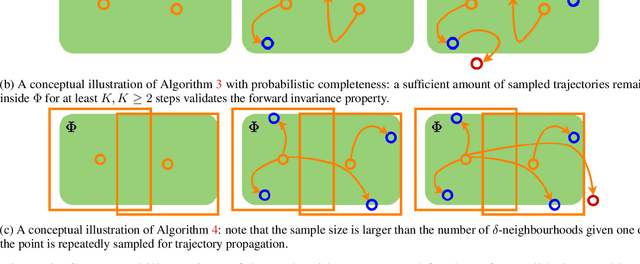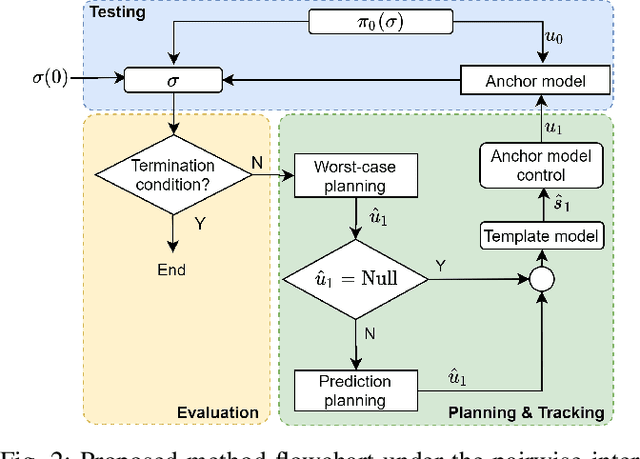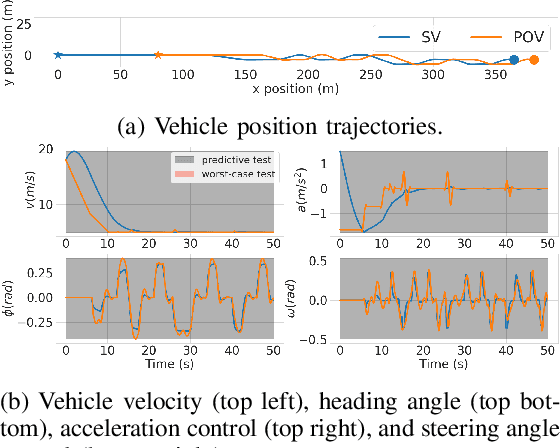Linda Capito
Rethink Repeatable Measures of Robot Performance with Statistical Query
May 13, 2025Abstract:For a general standardized testing algorithm designed to evaluate a specific aspect of a robot's performance, several key expectations are commonly imposed. Beyond accuracy (i.e., closeness to a typically unknown ground-truth reference) and efficiency (i.e., feasibility within acceptable testing costs and equipment constraints), one particularly important attribute is repeatability. Repeatability refers to the ability to consistently obtain the same testing outcome when similar testing algorithms are executed on the same subject robot by different stakeholders, across different times or locations. However, achieving repeatable testing has become increasingly challenging as the components involved grow more complex, intelligent, diverse, and, most importantly, stochastic. While related efforts have addressed repeatability at ethical, hardware, and procedural levels, this study focuses specifically on repeatable testing at the algorithmic level. Specifically, we target the well-adopted class of testing algorithms in standardized evaluation: statistical query (SQ) algorithms (i.e., algorithms that estimate the expected value of a bounded function over a distribution using sampled data). We propose a lightweight, parameterized, and adaptive modification applicable to any SQ routine, whether based on Monte Carlo sampling, importance sampling, or adaptive importance sampling, that makes it provably repeatable, with guaranteed bounds on both accuracy and efficiency. We demonstrate the effectiveness of the proposed approach across three representative scenarios: (i) established and widely adopted standardized testing of manipulators, (ii) emerging intelligent testing algorithms for operational risk assessment in automated vehicles, and (iii) developing use cases involving command tracking performance evaluation of humanoid robots in locomotion tasks.
Repeatable and Reliable Efforts of Accelerated Risk Assessment
May 30, 2024



Abstract:Risk assessment of a robot in controlled environments, such as laboratories and proving grounds, is a common means to assess, certify, validate, verify, and characterize the robots' safety performance before, during, and even after their commercialization in the real-world. A standard testing program that acquires the risk estimate is expected to be (i) repeatable, such that it obtains similar risk assessments of the same testing subject among multiple trials or attempts with the similar testing effort by different stakeholders, and (ii) reliable against a variety of testing subjects produced by different vendors and manufacturers. Both repeatability and reliability are fundamental and crucial for a testing algorithm's validity, fairness, and practical feasibility, especially for standardization. However, these properties are rarely satisfied or ensured, especially as the subject robots become more complex, uncertain, and varied. This issue was present in traditional risk assessments through Monte-Carlo sampling, and remains a bottleneck for the recent accelerated risk assessment methods, primarily those using importance sampling. This study aims to enhance existing accelerated testing frameworks by proposing a new algorithm that provably integrates repeatability and reliability with the already established formality and efficiency. It also features demonstrations assessing the risk of instability from frontal impacts, initiated by push-over disturbances on a controlled inverted pendulum and a 7-DoF planar bipedal robot Rabbit managed by various control algorithms.
A Finite-Sampling, Operational Domain Specific, and Provably Unbiased Connected and Automated Vehicle Safety Metric
Nov 15, 2021



Abstract:A connected and automated vehicle safety metric determines the performance of a subject vehicle (SV) by analyzing the data involving the interactions among the SV and other dynamic road users and environmental features. When the data set contains only a finite set of samples collected from the naturalistic mixed-traffic driving environment, a metric is expected to generalize the safety assessment outcome from the observed finite samples to the unobserved cases by specifying in what domain the SV is expected to be safe and how safe the SV is, statistically, in that domain. However, to the best of our knowledge, none of the existing safety metrics are able to justify the above properties with an operational domain specific, guaranteed complete, and provably unbiased safety evaluation outcome. In this paper, we propose a novel safety metric that involves the $\alpha$-shape and the $\epsilon$-almost robustly forward invariant set to characterize the SV's almost safe operable domain and the probability for the SV to remain inside the safe domain indefinitely, respectively. The empirical performance of the proposed method is demonstrated in several different operational design domains through a series of cases covering a variety of fidelity levels (real-world and simulators), driving environments (highway, urban, and intersections), road users (car, truck, and pedestrian), and SV driving behaviors (human driver and self driving algorithms).
A Formal Characterization of Black-Box System Safety Performance with Scenario Sampling
Oct 05, 2021



Abstract:A typical scenario-based evaluation framework seeks to characterize a black-box system's safety performance (e.g., failure rate) through repeatedly sampling initialization configurations (scenario sampling) and executing a certain test policy for scenario propagation (scenario testing) with the black-box system involved as the test subject. In this letter, we first present a novel safety evaluation criterion that seeks to characterize the actual operational domain within which the test subject would remain safe indefinitely with high probability. By formulating the black-box testing scenario as a dynamic system, we show that the presented problem is equivalent to finding a certain "almost" robustly forward invariant set for the given system. Second, for an arbitrary scenario testing strategy, we propose a scenario sampling algorithm that is provably asymptotically optimal in obtaining the safe invariant set with arbitrarily high accuracy. Moreover, as one considers different testing strategies (e.g., biased sampling of safety-critical cases), we show that the proposed algorithm still converges to the unbiased approximation of the safety characterization outcome if the scenario testing satisfies a certain condition. Finally, the effectiveness of the presented scenario sampling algorithms and various theoretical properties are demonstrated in a case study of the safety evaluation of a control barrier function-based mobile robot collision avoidance system.
Towards Guaranteed Safety Assurance of Automated Driving Systems with Scenario Sampling: An Invariant Set Perspective (Extended Version)
Apr 23, 2021



Abstract:How many scenarios are sufficient to validate the safe Operational Design Domain (ODD) of an Automated Driving System (ADS) equipped vehicle? Is a more significant number of sampled scenarios guaranteeing a more accurate safety assessment of the ADS? Despite the various empirical success of ADS safety evaluation with scenario sampling in practice, some of the fundamental properties are largely unknown. This paper seeks to remedy this gap by formulating and tackling the scenario sampling safety assurance problem from a set invariance perspective. First, a novel conceptual equivalence is drawn between the scenario sampling safety assurance problem and the data-driven robustly controlled forward invariant set validation and quantification problem. This paper then provides a series of resolution complete and probabilistic complete solutions with finite-sampling analyses for the safety validation problem that authenticates a given ODD. On the other hand, the quantification problem escalates the validation challenge and starts looking for a safe sub-domain of a particular property. This inspires various algorithms that are provably probabilistic incomplete, probabilistic complete but sub-optimal, and asymptotically optimal. Finally, the proposed asymptotically optimal scenario sampling safety quantification algorithm is also empirically demonstrated through simulation experiments.
A Modeled Approach for Online Adversarial Test of Operational Vehicle Safety
Sep 28, 2020



Abstract:The scenario-based testing of operational vehicle safety presents a set of principal other vehicle (POV) trajectories that seek to force the subject vehicle (SV) into a certain safety-critical situation. Current scenarios are mostly (i) statistics-driven: inspired by human driver crash data, (ii) deterministic: POV trajectories are pre-determined and are independent of SV responses, and (iii) overly simplified: defined over a finite set of actions performed at the abstracted motion planning level. Such scenario-based testing (i) lacks severity guarantees, (ii) is easy for SV to game the test with intelligent driving policies, and (iii) is inefficient in producing safety-critical instances with limited and expensive testing effort. In this paper, the authors propose a model-driven online feedback control policy for multiple POVs which propagates efficient adversarial trajectories while respecting traffic rules and other concerns formulated as an admissible state-action space. The proposed approach is formulated in an anchor-template hierarchy structure, with the template model planning inducing a theoretical SV capturing guarantee under standard assumptions. The planned adversarial trajectory is then tracked by a lower-level controller applied to the full-system or the anchor model. The effectiveness of the proposed methodology is illustrated through various simulated examples with the SV controlled by either parameterized self-driving policies or human drivers.
Optical Flow based Visual Potential Field for Autonomous Driving
May 30, 2020



Abstract:Monocular vision-based navigation for automated driving is a challenging task due to the lack of enough information to compute temporal relationships among objects on the road. Optical flow is an option to obtain temporal information from monocular camera images and has been used widely with the purpose of identifying objects and their relative motion. This work proposes to generate an artificial potential field, i.e. visual potential field, from a sequence of images using sparse optical flow, which is used together with a gradient tracking sliding mode controller to navigate the vehicle to destination without collision with obstacles. The angular reference for the vehicle is computed online. This work considers that the vehicle does not require to have a priori information from the map or obstacles to navigate successfully. The proposed technique is tested both in synthetic and real images.
Integrating Deep Reinforcement Learning with Model-based Path Planners for Automated Driving
Feb 02, 2020



Abstract:Automated driving in urban settings is challenging chiefly due to the indeterministic nature of the human participants of the traffic. These behaviors are difficult to model, and conventional, rule-based Automated Driving Systems (ADSs) tend to fail when they face unmodeled dynamics. On the other hand, the more recent, end-to-end Deep Reinforcement Learning (DRL) based ADSs have shown promising results. However, pure learning-based approaches lack the hard-coded safety measures of model-based methods. Here we propose a hybrid approach that integrates a model-based path planner into a vision based DRL framework to alleviate the shortcomings of both worlds. In summary, the DRL agent learns to overrule the model-based planner's decisions if it predicts that better future rewards can be obtained while doing so, e.g., avoiding an accident. Otherwise, the DRL agent tends to follow the model-based planner as close as possible. This logic is learned, i.e., no switching model is designed here. The agent learns this by considering two penalties: the penalty of straying away from the model-based path planner and the penalty of having a collision. The latter has precedence over the former, i.e., the penalty is greater. Therefore, after training, the agent learns to follow the model-based planner when it is safe to do so, otherwise, it gets penalized. However, it also learns to sacrifice positive rewards for following the model-based planner to avoid a potential big negative penalty for making a collision in the future. Experimental results show that the proposed method can plan its path and navigate while avoiding obstacles between randomly chosen origin-destination points in CARLA, a dynamic urban simulation environment. Our code is open-source and available online.
 Add to Chrome
Add to Chrome Add to Firefox
Add to Firefox Add to Edge
Add to Edge